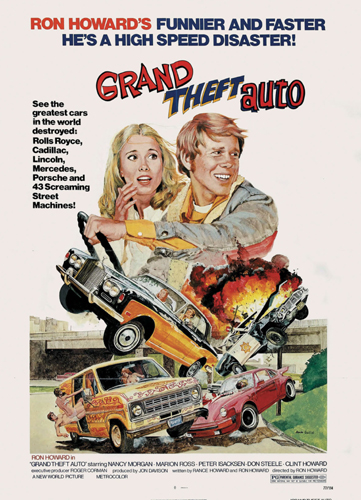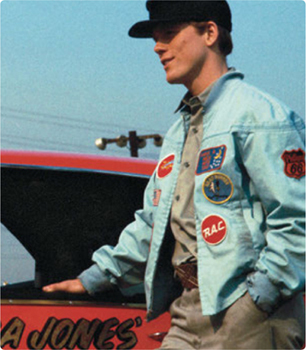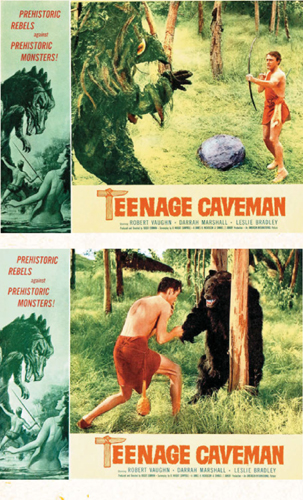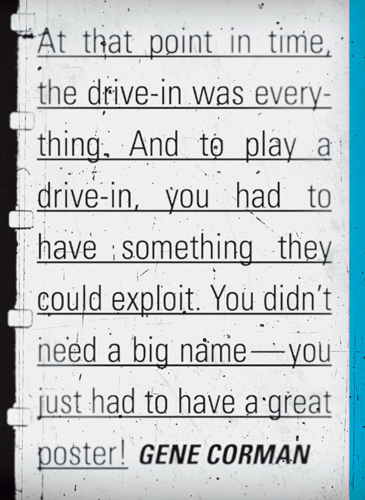
U.S. theatrical poster for Grand Theft Auto (1977), one of a slew of rock ’em, sock ’em car-crash comedies that Roger Corman produced in the 1970s. What made this one different, though, was the young man behind the camera—a still-baby-faced, twenty-three-year-old former child star named Ron Howard, who would go on to direct such critical and box-office hits as Splash, Apollo 13, and A Beautiful Mind. Howard was just one in a long list of A-list Hollywood filmmakers who would learn how to direct on Corman’s dime.
Chris Nashawaty
PREFACE
In 1977, Ron Howard was nervously pacing on the set of his directorial debut, a $600,000 car-crash romp called Grand Theft Auto. Despite a successful career as a freckle-faced young actor on The Andy Griffith Show and Happy Days, the twenty-three-year-old had always wanted to work behind the camera rather than in front of it. A year earlier, he’d reluctantly agreed to star in the similarly themed girls-and-hot-rods cheapie Eat My Dust on the condition that the film’s producer, Roger Corman, would let him direct a movie of his own when it was over. Corman was notoriously thrifty—some would say cheap—but he was also a man of his word.
So there was Howard, standing on the set, facing the same frustrations that so many of Corman’s directors had faced countless times before him: The shooting schedule was too rushed, the crew was too small, and the money he needed to hire several hundred extras for a crowd scene was nonexistent. Just then, Corman arrived on the set of Grand Theft Auto and noticed that Howard was anxious about the B-movie producer’s refusal to pay for more faces in the crowd. Corman put his hand on the young director’s shoulder, smiled, and said, “Ron, I’m not going to give you more extras. But know this: If you do a good job for me on this picture, you’ll never have to work for me again.”
Howard never did work for Corman again. Instead, he graduated to making big-budget movies like Splash, Apollo 13, and A Beautiful Mind. But to this day, Howard insists that he never would have gotten the chance to work for the major studios had it not been for his apprenticeship at “The University of Corman.” He’s not alone. The list of directors, screenwriters, cameramen, producers, and actors who got their starts at Corman’s subversive celluloid prep school reads like a Who’s Who of Hollywood’s A-list: Francis Ford Coppola, Martin Scorsese, Jack Nicholson, James Cameron, Robert De Niro, Sylvester Stallone, Dennis Hopper, Peter Fonda, Jonathan Demme, Charles Bronson, Joe Dante, John Sayles, Peter Bogdanovich, the list goes on. …

Ron Howard with one of his four-wheeled costars on the set of Eat My Dust (1976), directed by Charles B. Griffith. The Happy Days star was frustrated with his television career when he met with Corman and made a gutsy proposal: He would star in Eat My Dust only if Corman would give him the chance to direct a picture of his own. A rare Hollywood deal that worked out for both sides.

Lobby cards for Teenage Caveman (1958), directed by Roger Corman.
If Roger Corman’s legacy began and ended with the star-studded careers he kick-started, his story wouldn’t be nearly as compelling as it is. Since the 1950s, Corman has directed fifty movies and produced four hundred—movies with screaming titles like Attack of the Crab Monsters, The Beast with a Million Eyes, and Creature from the Haunted Sea. He spun wild tales of Teenage Cavemen, T-Bird Gangs, and Slumber Party Massacres. And he packed drive-ins with the steamy, R-rated exploits of Candy Stripe Nurses, Women in Cages, and Wild Angels. Beyond the films themselves, Corman’s career may be the closest thing there is to a through-line of the past sixty years in Hollywood. He revolutionized independent cinema, he was the first person to recognize a previously untapped teen audience and then exploit the hell out of it, and he brought a Barnumesque huckster’s flair for showmanship to the marketing of his movies, hyping them with eye-popping posters and rat-a-tat trailers. He also distributed art house imports by foreign auteurs like Federico Fellini, Akira Kurosawa, and Ingmar Bergman when no one else dared to, helping to broaden the palate of American moviegoers. In short, there is, was, and never shall be another Hollywood character like Roger Corman—something the Motion Picture Academy of Arts and Sciences finally acknowledged in 2009, when it handed him a lifetime achievement Oscar statuette.
In 2009, when I first spoke to Ron Howard about his years at the University of Corman, he told me, “When you’re among the graduates of the Roger Corman School of Popular Cinema, the war stories fly.” Eager to hear more, I interviewed more than sixty Corman alumni and let them recount their battle-scarred tales. …

Lobby cards for Creature from the Haunted Sea (1961), directed by Roger Corman.







